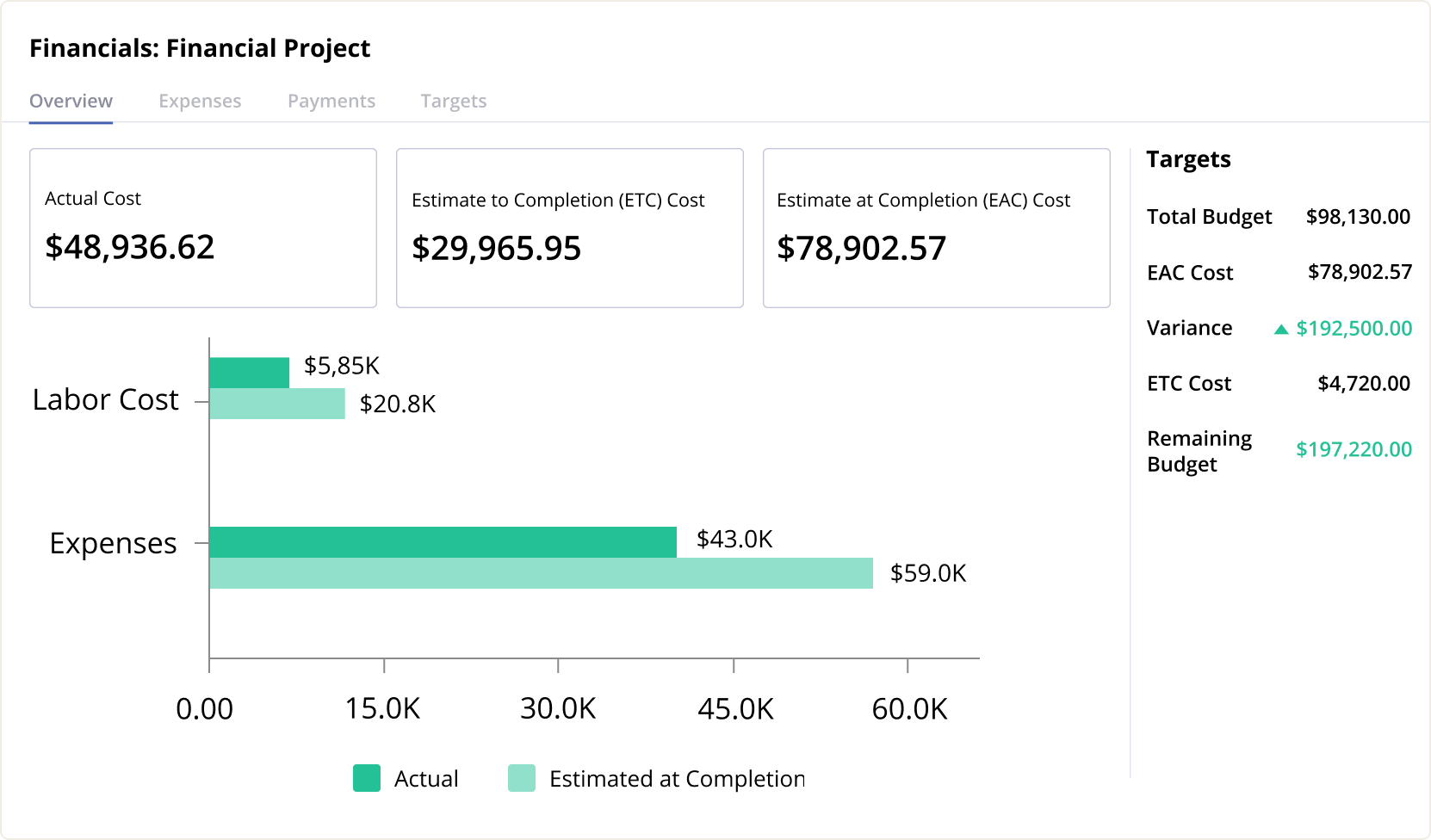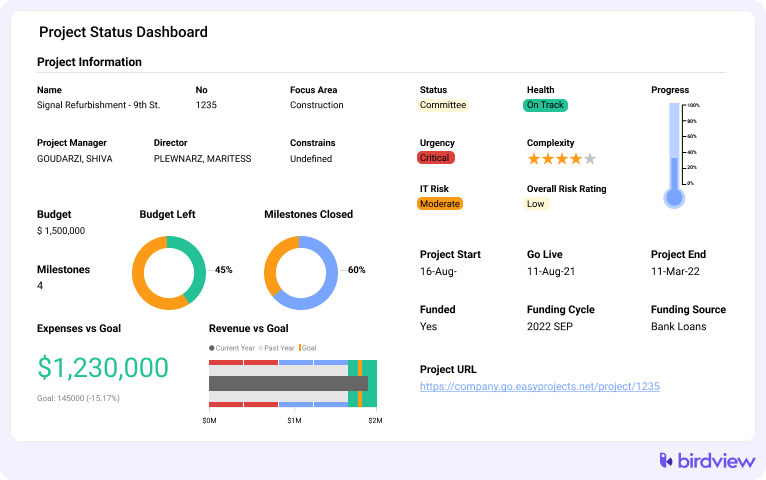What is cost overrun?
When you overrun your costs, it means the project‘s actual costs exceed the allocated or estimated budget. According to a study by McKinsey, 66% of technology projects experience cost overruns, with 20% of them falling short of delivering the expected results. Quite a problem, right? So, what are the common causes of such a disparity?
✔ Inaccurate cost estimates: This simply means the team tasked with preparing the budget underestimated the required resources or project scope.
✔ Unforeseen risks: Sometimes predicting the future can be a tough ask. That means unforeseen circumstances can emerge leading to sudden changes in scope, materials, or labor costs.
✔ Ineffective communication: Lack of communication between stakeholders and the project team can lead to serious cost overruns.
Cost overrun in project management
Project management professionals often deal with cost overruns. This impacts many aspects of a project, including scope, schedule, and quality of deliverables. When costs exceed expectations, project managers often have to make difficult decisions. These decisions often involve reallocating resources. Sometimes, the project scope has to be reduced, or stakeholders have to negotiate to extend the project.Cost overruns impact our current projects in the following ways:
✔ Delays: One of the two most common results of costs is a significant supply shortfall. Budget problems can delay project schedules and further increase costs.
✔ Deterioration in quality: When project managers notice discrepancies between actual and projected costs, they need to take action.
The first step is to cut costs in an attempt to control costs. Cutting costs means that some aspects of the project may suffer. The result is lower quality products.
✔ Stakeholder dissatisfaction: Any delay or more is bound to impact stakeholders. Moreover, persistent excessive cost overruns undermine trust and can damage the relationship with the client.
Exceeding the time and cost of project management
Time and cost overruns are linked. Any change on one side directly affects the other. For example, when a project exceeds its deadline, additional costs will follow.
✔ According to McKinsey research, large projects in various sectors typically go 80% over budget and 20% over schedule.
A good real-life example is a construction project delayed due to adverse weather conditions. This can result in higher wages because workers are on-site longer than originally planned. On the other hand, excessive costs can also cause delays. If budgets are tight early in the project, the team may have to wait for additional funding or stakeholder approval.

Why is it important to manage risk to control costs?
Unmanaged risks often result in cost overruns. For this reason, it is critical to make risk management a key component of project success. This means that as a project manager, you need to identify, assess, and mitigate risks early on. in the project life cycle.Before we explain why Let’s define risk management. Risk management is generally about identifying potential threats to a project’s timeline, budget, or quality and creating plans to deal with threats before they spread.
Let’s identify the main risks of cost overruns. First of all, there are technical risks related to the design, technology, or engineering requirements of the project. We should not forget about operational risks, such as disruption of workflow due to equipment failure, employee problems, or management inefficiencies. Particularly dangerous are external risks related to changes in the market, regulatory changes, or supply chain disruptions that affect resources or schedules.
How can we find the causes of cost overruns and prevent them?
To find a solution, you first need to understand the problem. As a project manager, it is important to know the causes of excess costs so that you can implement proactive preventive measures.
Here are some tips:
The role of technology in preventing cost overruns
Technology is a fundamental ally in our current project environment. This is especially true when it comes to managing expenses and preventing budget overruns.
How technology can be used to control budgets and allocate resources effectively
1. Track expenses in real time
It isn’t easy to monitor the progress of a project at each workstation. However, with project management software like Birdview PSA, you can track project expenses in real-time.

2. Automate routine expense control processes.
Isn‘t it tedious to deal with repetitive tasks? Wouldn‘t it be great if you could automate complex tasks like creating expense reports and invoicing?
Automation allows project managers to focus on higher-level activities like analyzing financial data, forecasting future costs, and adjusting budgets in real-time.
✔ According to McKinsey, organizations that invest in automation and IA can achieve cost savings of up to 15% on their projects.

3. Improved forecasting and budget planning
Project management software typically includes tools to help forecast and plan future expenses.
Technology that analyzes historical data, resource allocation, and other important factors can help create accurate financial forecasts.
Forecasting tools are especially useful in large, complex projects. For example, if a delay in one phase of an engineering project is likely to result in increased material or labor costs later on, advanced forecasting tools can alert the project manager in time to take corrective action.
Example. Suppose a project begins to experience shortages in allocated resources, such as materials, equipment, or human capital. Project management software allows you to update budget estimates to reflect these shortages. Project managers can see the direct impact of resource constraints on the overall project cost and make adjustments in real-time.
Cost overruns are a recurring problem for many project managers. They result in financial losses, delays, and decreased stakeholder confidence. However, this is not always the case. At least not without the right strategy and tools. By understanding the causes of unnecessary costs Whether it is poor time management, incremental scope creep, or unforeseen risks, project managers can take proactive steps to prevent these issues from affecting their projects.
How to prevent cost overruns with Birdview PSA
Let‘s take a look at Birdview PSA, a turnkey project management platform designed to help teams manage projects and control budgets, timelines, and resources. With real-time tracking, automated reporting, and advanced analytics, Birdview PSA helps project managers prevent cost overruns. Birdview PSA provides complete visibility into project costs. Expense tracking is one of the project savings features you will find in Birdview PSA.
What is project billing (revenue)?Time and Cost Tracking



